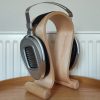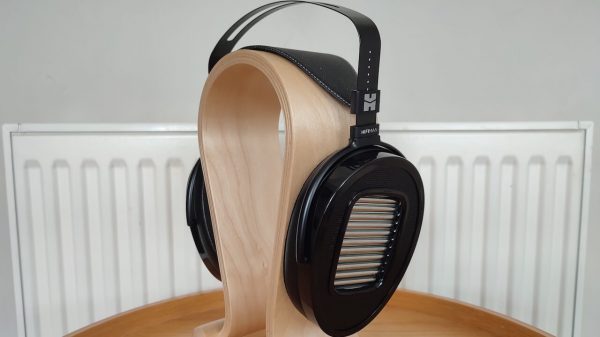When HiFiMAN unveiled the new flagship SVANAR wired IEMs, there was a lot of community excitement over the design with its brass interior shell shaped to the human ear and updated dynamic topology driver that was very popular in the RE2000 IEM that they introduced a few years ago.
Having only had a few opportunities to compare the Svanar IEMs to my RE2000 Silver which I use rather frequently, my assessment was that they do offer a rather large uptick in performance and that HiFiMAN has clearly figured out how to engineer very high-performance universal IEMs — which are admittedly not very affordable at $1,999 USD.
The next logical progression for HiFiMAN was to create a wireless version of the Svanar; but unlike other products that have been released over the past few years, there is no Bluetooth adapter for the wired IEMs and the new model is completely wireless; it utilizes new technology developed specifically for the new Svanar Wireless range and some of the technology in the $1,999 IEMs.
The HiFiMAN Svanar Wireless Earbuds retail for $499 so it was rather unrealistic to expect a product that was going to offer all of the sonic benefits of its wired siblings at such a substantial discount.

Technology
The exterior is the first major difference because whilst both models share the same shape for the interior shell, the materials and construction methods are quite different.
The inner shell on the Svanar Wireless is constructed from molded carbon fiber rather than the machined brass of the wired IEMs. This helped reduce the cost and thickness of the materials allowing for more space internally while not sacrificing stiffness in the process.
The mid shell and outer shell are stamped metal; which also allowed for the use of thinner materials and simplifying the assembly process.
One difference in the design of the shells compared to most wireless earbuds is that the charging pads are not on the inner surface but instead rest on the bottom and require the mid-shell to be drilled and the pads electrically isolated.
This is one departure from the cost-saving measures because carbon fiber is conductive and it does not naturally isolate the contact pads in a similar manner as an acrylic or polymer shell would.
The inner shells are quite comfortable while the outside shell is quite angular adding to the mixed signals.


Wireless Support and Drivers
Internally, the Svanar Wireless earbuds utilize a topology driver like its sibling, although the provided documentation doesn’t state whether the two are using exactly the same driver or a variation.
The Bluetooth implementation, however, is very unique to the wireless version and hides a big surprise.
The Svanar Wireless uses Bluetooth 5.2 and supports LDAC, SBC, and AAC — but instead of relying on the Bluetooth chip to do the audio decoding which is standard for most products, the Svanar Wireless incorporates HiFiMAN’s Hymalaya R2R DAC and discrete amplifiers after the Bluetooth implementation.
This allows for 24-bit/96kHz decoding if using LDAC, but not for the other two codecs.
The Svanar Wireless offered roughly 6.5 hours battery time per charge during my testing and with ANC engaged it dropped to 4 hours; which proved to be rather confident with LDAC high quality streaming.
The case adds an additional 3 charges before it needs to be recharged as well; the ear pieces recharge completely in roughly an hour and the case takes twice that when charged using USB Type-C charging.
Wireless charging is supported but more than doubles the charging time, making it a better option for an overnight charging session instead of a quick charge.

Case and Controls
The case might be the most controversial part of the design although I applaud HiFiMAN for trying something different from a visual perspective.
The angular clamshell design looks like nothing else on the market and HiFiMAN might be the first manufacturer to acknowledge that the internal compartments for the ear pieces needs to be larger to accommodate large ear tips; that was actually a very smart decision because foam ear tips don’t often fit wireless charging cases very well.
Cough. Sony. Cough.
The most obvious negative is that the case is on the larger side, and combined with the angular shape, is not the easiest thing to carry in your pants pocket or shirt pocket. I took it with me on the train and whilst walking and it never felt very comfortable. You will definitely need to put it inside a jacket pocket or your knapsack or laptop bag.
The positioning of the charging connectors doesn’t make sense either; placing them on the bottom makes it impossible to charge the case with the lid open.
The touch controls are mandatory, because there is no app to support the Svanar Wireless at this point; which will also make it more difficult to upload firmware updates (when they might become available).
Not having a control app in 2023 at this price point is not acceptable.
Touching the left ear piece for 3 seconds switches between HiFI (default setting), ANC, and Transparency mode.
To activate the Transparency mode, one has to touch the controls for 3 seconds and release when you hear the ANC prompt, before touching the control again to activate it.
During playback, a single tap of either ear piece pauses and restarts the music, whilst a double tap answers calls.
Volume control is through your source device.

Listening
My initial listening started in “Hi-FI” mode and we found it be rather temperamental; whilst the initial sound quality was quite good, it became apparent that the distance between my source devices (iPhone and Samsung Android Phone) and the earbuds needed to be kept rather short.
When I walked out of the room and lost line of sight with the earbuds, there were immediate cut-outs of the sound.
HiFiMAN does warn users that this can occur and suggested dropping back to AAC or SBC when it happens.
The issue is that it defeats the purpose of using a 24-bit/96kHz internal R2R DAC, which meant limiting my usage of the “Hi-Fi” mode to listening sessions where my phone was either in my lap or sitting on the table right in front of me.
One two occasions, someone in the adjacent kitchen began to microwave something and the signal from the source device dropped.
Frustrating to say the least.
Sonically, the Svanar Wireless impresses immediately in the bass range with very solid low end punch and extension; notes are extremely well defined, quick, and full of texture.
Electronic music is delivered with excellent pace and impact; fans of techno and electronica will find themselves digging into the deepest grooves and feeling every part of it.
Film scores are also well served with these wireless earbuds; large orchestral pieces, car chases, and explosions never overwhelm the rest of the bass range or bleed into the lower midrange.
The mid-bass has slightly less emphasis but is certainly not completely neutral; one can discern some additional coloration but it still delivers enough texture and solid pacing.
The upper bass is clean, tight, and there is no bleed into the lower midrange.
The lower midrange benefits from the strong performance of the bass range and offers a rather accurate sounding tonal balance with good note weight and texture; male vocals are rich, clear, and presented with more than enough detail.
Lower strings have very good clarity and detail and whilst there is a degree of emphasis in the upper midrange, it never caused them to sound too energetic to the point that they no longer sound accurate.
Female vocals cut through the instrumentation with clarity and detail, but never push too far forward in the soundstage to distract from the rest of the music. No matter how hard I pushed the Svanar Wireless with average sounding recordings, female vocals never exhibited any hardness or thinness at all.
Guitar tracks had a very strong edge with excellent presence; acoustic guitar was not as prominent but there was nothing about its presentation that made it sound too thin.
“Hi-Fi” mode is where the treble exhibited some additional emphasis that I never found overly smooth sounding; poor recordings came across as somewhat hard and it was where one could easily discern the differences between sources and good recordings and rather poor ones.
Percussion had good snap, but cymbals were a mixed bag; some tracks had the right amount of energy and detail whilst others could be described as metallic clicks.
The treble demonstrates a sufficient amount of airiness and detail, but this also means that the Svanar Wireless can become somewhat fatiguing.
It is an honest approach that highlights the differences between good and really poor recordings and if you desire a pair that doesn’t paint a rather pretty picture of everything — these might work for you rather well.
Soundstage performance is good but it would be inaccurate to say that it offers a very spacious sounding presentation; both width and depth are about equal but generally on the smaller side.
Seating the orchestra feels somewhat cramped but instrument separation is good enough to mitigate the overall size issue.
Imaging is good with movements easily tracked but there are limitations to the size of the stage which prevent it from approaching the best wireless earbuds in that regard.
On some tracks, when the vocalist or instrument should fade further back into the mix, they often take that first step back but never really make it.
ANC Performance
Switching to ANC mode had some notable impact on the overall sonic performance; the bass range lost some of its overall impact which was not a good development considering the high level of performance with it disengaged.
The treble range also lost some of its detail and openness which made the Svanar Wireless sound somewhat dull.
The biggest change was in the soundstage which sounded narrower and somewhat congested. There was also some audible hiss between tracks that was hard to ignore.
Overall, the Svanar Wireless delivered middle of the pack ANC performance which was rather disappointing considering the $499 asking price.

Final Thoughts
The HiFiMAN Svanar Wireless were somewhat frustrating to review for the simple reason that the rather strong sonic performance was ultimately hindered by some odd operational quirks.
Listening to music in Hi-Fi mode was quite satisfying but it also demands that you are stationary and listening in a quiet environment. The issues with drop-outs hindered what should have been the best aspect of the design — using LDAC to experience hi-res streaming through a very good R2R DAC.
Switching to AAC or SBC solves the issue but does one need to spend that kind of money to only experience that level of codec support?
Battery life is acceptable but certainly not at the level it needs to be when less expensive competitors offer superior battery performance for less money.
The charging case is well made and does offer more internal space for larger tips and that is a plus for users such as myself who require them.
HiFiMAN invested a lot of money in the technology for its Svanar wired IEMs which have proven to be a fantastic product; they should be on your audition list if your budget is between $1,500 and $2,000 USD.
Those expecting that level of performance from the Svanar Wireless will be disappointed that the aforementioned quirks don’t allow it to perform to that level.
The HiFiMAN Svanar Wireless, however, have the sound quality aspect of the equation figured out.
If the sound quality with ANC engaged was 90% of that level of performance and the battery life was improved — these would be a rather easy recommendation.
Where to buy: $499 at Amazon
Tip: HiFiMAN has recently released two more affordable wireless ANC earbuds — SVANAR Wireless LE ($299) and SVANAR Wireless Jr. ($179).



































